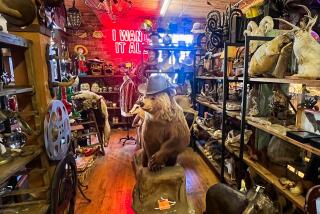Classic Hollywood: Motion pictures in still photos
Over the last 41 years, film historian and author Marc Wanamaker had acquired some 200,000 photographs chronicling the history of film production in North America from 1909 until the present day. Many of these photographs are one of a kind.
Eventually, he sold the photos to Cecilia DeMille Presley, granddaughter of filmmaker Cecil B. DeMille. Then last month, the Academy of Motion Picture Arts and Sciences received more than 70,000 of those photographs from Presley.
FOR THE RECORD:
Movie photos: In the April 23 Calendar section, the Classic Hollywood column said that Marc Wanamaker’s Bison Archives had donated more than 70,000 photographs chronicling the history of film production in North America to the Academy of Motion Picture Arts and Sciences. Wanamaker sold the photos to Cecilia DeMille Presley, the granddaughter of filmmaker Cecil B. DeMille, who, in turn, donated them to the academy. —
But it all started with Wanamaker and his penchant for the behind-the-scenes filmmaking-related photos; he established Bison Archives, naming after the old Bison Film Co. “It is one of my favorite companies because they made films about Sioux Indians from a Sioux point of view in 1909,” Wanamaker said.
FOR THE RECORD:
Movie photos: An earlier version of this online article said that Marc Wanamaker’s Bison Archives had donated more than 70,000 photographs chronicling the history of film production in North America to the Academy of Motion Picture Arts and Sciences. In fact, Wanamaker sold the photos to Cecilia DeMille Presley, the granddaughter of filmmaker Cecil B. DeMille, who, in turn, donated them to the academy.
Indeed, he had traveled the world to find these photos. The collection will also play an important part in the academy’s planned museum.
The academy’s Margaret Herrick Library at the Fairbanks Center for Motion Picture Study has more than 10 million photographs, but library director Linda Harris Mehr said that the Bison collection “supplements what we have,” notably the behind-the-scenes shots of filmmakers at work.
“It is incredible in its depth about all the studios and the activities there,” she noted. “These stills give you directors at work, art directors at work and editors at work. Everybody gets a better sense of what went on.”
The collection features images from more than 100 major and independent studios — several of which stopped production films after the 1920s, including Biograph, Edison, E&R Jungle Film Co., Essanay and Vitagraph.
“These stills give you directors at work and art directors at work and editors at work — all the crafts,” said Mehr, who adds that researchers have already made good use of the collection. “I understand there have been a number of researchers who have been thrilled to find things they didn’t have access to them before.”
More to Read
The biggest entertainment stories
Get our big stories about Hollywood, film, television, music, arts, culture and more right in your inbox as soon as they publish.
You may occasionally receive promotional content from the Los Angeles Times.







